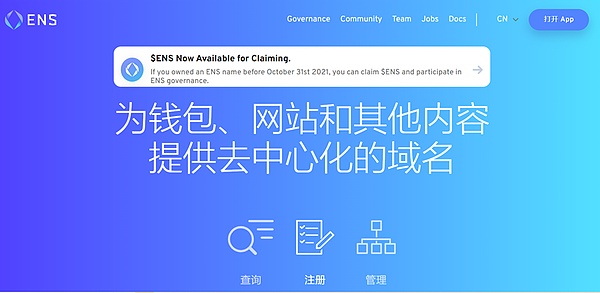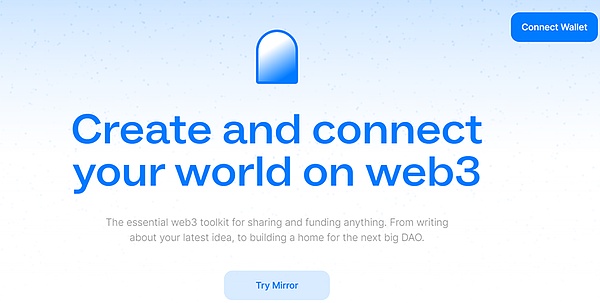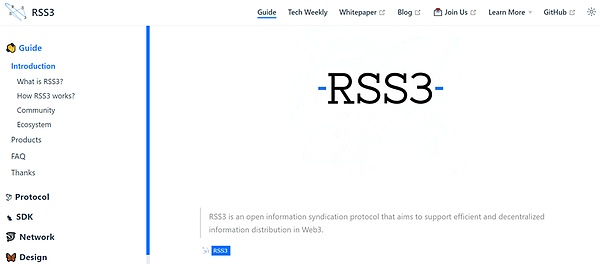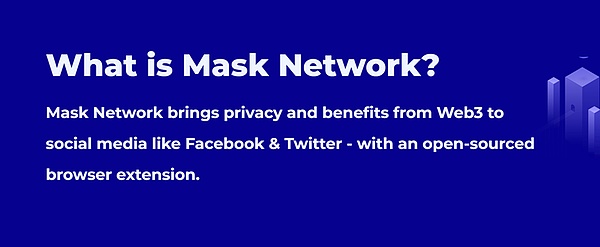Among the on-chain applications spawned by the crypto asset boom, in addition to scenarios such as DeFi, NFT, and chain game GameFi, there is also a hot word called “Web3.0”.
The concept of Web3.0 first appeared in 2014. It was first mentioned by Gavin Wood, co-founder of Ethereum and creator of Polkadot . The system will contain a series of open source protocols that can provide building blocks for application developers, while the Web3.0 platform and applications built on blockchain technology are not owned by traditional centralized enterprises, and the rights and assets given by the network are owned by the network. Owned by developers and users.
Changing the ownership of web products sounded dreamy at the time, but in 2014, Web 3.0 was really just a concept. From 2020 to 2021, open finance-based applications on the Ethereum chain will gradually emerge, and multiple public chains will enter the market and create a competitive relationship. NFT, chain games, and virtual space on the chain will begin to become application scenarios other than DeFi. , “Decentralized Ecosystem Network” begins to become implementable.
In addition to the prosperity of public blockchains and applications, capital has begun to intervene. A16z, a well-known venture capital institution in the encryption field, has reintroduced Web3.0 and began to invest funds in this subdivision.
Today’s mobile Internet is regarded as Web2.0 by Web3.0 fans, and the earlier Internet is even classified as Web1.0. Blockchain enthusiasts have sorted out the iterative history of the Web like this:
- Web1.0 mainly refers to readable static web pages, mainly one-way reading, what the network provides, the user gets what, such as the early portal website;
- Web2.0 mainly refers to readable and writable platform websites or apps, that is, in today’s “Internet + mobile Internet” era, users can participate in creation, fill in content, and enhance interactive sharing. Such as Amazon, Twitter and all kinds of apps that can be loaded on mobile phones. They provide platform-style products and services by enterprises. The rules are formulated by the platform, and the content is controlled by the platform. Although users have platform accounts, the data is not in the hands of users. The platform makes profits through user traffic, and commercial profits belong to the enterprise. , which has little to do with ordinary users;
- In addition to the “readable and writable” function of Web2.0, the most important feature of Web3.0 is that the content and data of the application belong to the creators themselves, and they are recorded on the public blockchain network. The purpose is to allow the public network to generate The value of the return to the user’s individual hands.
Compared with the functionality of the application, Web 3.0 attempts to reconstruct the value through a decentralized network and change the production relationship between the Internet, developers and users. To put it figuratively, Web 3.0 attempts to eliminate the “middlemen” (giants of Internet companies), to match the direct contact between producers (application developers) and consumers (users), and attempt to build a brand new business between users and applications. model.
If we say that Web3.0 starts with value, blockchain and the new economic system it brings are indispensable. Decentralized network technology that does not rely on centralized servers is one aspect. The Token required for network operation constitutes the The economic model of “contribution and reward”, technology ensures the personalization of data and information, and the economic model determines the new distribution of value.
The infrastructure brought by the blockchain network is improving. For example, encrypted wallets have replaced account registration and become a new entrance to the decentralized network and its applications. It is also one of the infrastructures of Web3.0. In addition, what infrastructure does Web3.0 have? Does it have application support? This issue of DeFi Honeycomb will bring relevant inventory.
Web3.0 domain name service provider ENS
Introduction
The full name of ENS is ” Ethereum Name Service”. It is a decentralized domain name service provider built on Ethereum. This tool simplifies the Ethereum address. It can convert the Ethereum address starting with 0X, uppercase and lowercase letters and numbers into A domain-like name “xx.eth” that is easy for people to remember and identify.

ENS official website
Operation Mechanism
ENS provides readable name resolution services for blockchain personal addresses, on-chain application addresses, etc., and provides a unified standard for the naming of blockchain users.
To put it bluntly, ENS solves the problem of readability of the identity on the chain. It translates the addresses on the chain into a way that ordinary people can easily identify and use, and parses a series of disordered characters into the domain name language “xx. eth”.
Just like when we use the website now, we don’t need to enter the IP address in digital style, just enter the website name. Since the blockchain has the function of value transmission, with ENS, when people transfer value on the chain, they no longer need to enter an address composed of complex characters, and only need to enter the ENS domain name bound to the address.
Although ENS is built on Ethereum, it is not limited to Ethereum, it supports multi-chain address resolution. Users can resolve the same ENS domain name to multiple blockchain network addresses such as Bitcoin and Litecoin. When transferring value on these networks, users can use the same domain name to send and receive various blockchains with the help of a multi-chain wallet. network assets. Several decentralized wallets have begun to support the function of retrieving address domain names.
In addition to personal address resolution, the ENS domain name can also be the name of a decentralized network or decentralized application. It has content addressing functions. Users can find the entrance by searching the ENS domain name of the network or application. For example, Uniswap has already used ENS to establish Decentralized website uniswap.eth.
In addition, the ENS domain name supports binding with the user’s Internet social account, and the NFT avatar can be set as the ENS domain name avatar, so that the user’s information can be bound to the identity on the chain in an all-round way. The right to use the ENS domain name belongs to the user. The user controls their personal information and data, and brings it to every DApp application on the chain that they use, becoming the user identity proof in the Web3.0 era.
Decentralized content creation platform Mirror
Introduction
Mirror is a content creation tool that logs in from the wallet on the chain. Users log in to the tool by linking the encrypted wallet and start writing. The content is stored on the decentralized data storage platform Arweave. The article records follow the creator’s wallet address, and the content creation will not. Disappeared because of the closure of Mirror.

Mirror official website
In addition to writing, Mirror combines wallet entry + decentralized storage technology to reconstruct the way people express, share and profit from content, combining creators’ data ownership, user interaction, and economic system.
Mirror is similar to a decentralized version of Medium. The difference is that it is not only a content creation tool, but also supports community collaboration and provides creators with Token issuance tools to help crowdfunding.
Operation Mechanism
Mirror is divided into 7 main functions, including article publishing, fund crowdfunding, revenue sharing, NFTization, auction and voting.
For content editing on Mirror, crowdfunding and bidding information can be inserted, and articles can also be NFTized. Of course, this process requires paying on-chain fees for minting NFTs. When the content becomes NFT, it can be collected or purchased by readers, providing a monetization channel for creators. If the article is co-authored by multiple people, it can also automatically set up a proportional split of revenue through smart contracts. Collectors of article NFTs have permanent reading rights.
Mirror’s crowdfunding feature allows users to raise funds through projects or ideas, and it’s also a tool to quickly launch a DAO for decentralized organizations. The initiator of a certain idea needs to fill in the project name and details according to the crowdfunding code of conduct, set the target amount of crowdfunding and the way of feedback, and supporters can get project rewards or NFT.
You can publish an article in Mirror, explaining a product idea, or write a research report, or even plan to make a movie. For your idea, you can create a crowdfunding, bring together the initial members of the community, involve early users in the project, and give them special rewards. The function of community collaboration to complete creation can aggregate the talents of community users, and the voting function supports users to choose the development route, implement the use of funds, and allocate funds for use. After the achievement is achieved, you can package it as an NFT auction, and the income can be distributed according to the crowdfunding share.
Mirror is a tool that can be integrated with DAOs and can also be used as an incubator for innovative projects. Distributed collaboration provides creative tools and capabilities for brainstorming, and can even evolve into a roadshow platform.
It should be noted that Mirror has not issued any tokens at present, and it is still a heavily used tool.
Decentralized content distribution platform RSS3
Introduction
The full name of RSS3 is Really SimpleSyndication 3.0 (Simple Information Aggregation). It is a decentralized information aggregation platform designed to support Web3.0 information dissemination and distribution.

RSS3 official website
The traditional “RSS subscription” allows users to actively subscribe to content. As long as the web content developer adds an RSS program, users can subscribe to different blogs, news media and other web content according to their personal preferences. However, due to the upgrade of centralized content websites in the later period, the display of content is no longer simply arranged in chronological order, but is recommended by algorithms to screen information content for platform users.
In order to protect their own interests, the centralized platform does not disclose the screening mechanism, which makes it troublesome for users to use RSS subscriptions. Later, the developers of “RSS subscriptions” no longer operate because the products are difficult to realize.
DIYgod, the co-founder of RSS3, said that while RSS3 pays tribute to the “historical RSS subscription”, it is also evolving to Web3.0, and “3” stands for “Web3.0”.
RSS3 believes that in the future Web3.0 world, content will be scattered in various decentralized networks. If users want to read content, they need to go to a decentralized platform to search, and if these decentralized content platforms do not It is very troublesome for users to use the search function. For example, Mirror currently only has a creative editor. If readers want to read the above content, they usually need to rely on the creator to promote it in other channels, which brings inconvenience to current Internet users.
RSS3 hopes to solve the above-mentioned problems, aggregate the information on the decentralized content platform, users can subscribe and view according to their own preferences, and provide new communication channels for these content creators.
Operation Mechanism
RSS3 aggregates and presents content without relying on a centralized platform, and achieves decentralization at the storage level. Accordingly, it launched Cheers (Web3 Pass profile) and Revery (news digest aggregator) two products.
- Cheers——It is similar to the user profile of Twitter’s personal homepage. RSS3 imitates the personal pages of Web2.0 social platforms. Users can freely set ENS domain names, edit personal files, and allow users to connect wallets, user signature verification, etc. Obtain on-chain footprints and present individual activities on the decentralized network, such as NFT purchases, collections, etc. Users can display the Cheers profile on Twitter or Mirror, and others can view and follow your profile at any time.
- Revery – It is an aggregator of subscription and reading information, which realizes the flow of information flow between different personal homepages, that is, users can track their subscription content, including the trends of different DApps, NFT collection types, and content published on Mirror , participating DAOs, etc., you can also search the content you are interested in through the recommendation section. In the future, it will also support tracking the latest progress of applications on the subscription chain.
Compared with the decentralized personal files of the centralized Internet, RSS3 products are designed to aggregate information on multiple platforms in a large amount, and display user behaviors in multiple dimensions, especially the interaction of applications on the chain. In the future, users can participate in social networking in a trustless manner by virtue of their personal profiles on RSS3.
RSS3 attempts to map user-created content from a centralized platform to RSS3, get rid of the absolute control of the Web2.0 platform on content, and then aggregate information on an independent website to build a decentralized that can be subscribed to and associated with each other. content network.
In RSS3, users can store data on a decentralized network. Combined with the traditional RSS subscription method, users can effectively aggregate information on a large scale under their preferences and choices, realizing the convenience of reading decentralized content.
Web3.0 transition plug-in Mask Network
Introduction
In 2019, MaskNetwork (MASK), founded by former Chinese journalist and engineer Suji Yan, is an intermediate plug-in application that helps users seamlessly transition from Web2.0 to Web3.0.
Mask Network allows users to seamlessly send crypto assets in traditional social platforms such as Twitter, Facebook, Instgram, etc., and even experience decentralized applications such as DeFi, NFT, and DAO.

Mask Network official website
Operating mechanism
Mask Network did not directly try to subvert the existing centralized Internet giants. It took into account the reality that it is difficult for users to leave traditional social media at the beginning of its design. Therefore, it adopts a softer method and uses plug-ins to guide users to decentralized areas. The blockchain network migration also facilitates users to have a better experience in the process of participating in Web3.0.
The role of the plug-in is to break the blockade of the Internet in the past and become a bridge linking Web2.0 and Web3.0. There are already many well-known plug-in tools on the market, such as the oracle Chainlink, which transmits off-chain data existing on the Internet to the blockchain network, but because it serves smart contracts, individual users cannot perceive it.
The tool form of Mask Network provides Internet users with more choices. By adding a third-party plug-in to the traditional Internet platform, users can experience operations such as sending encrypted information, trading encrypted assets, and trying DApps.
For example, users who add the Mask Network plug-in to the Twitter platform can experience sending encrypted messages. In addition, the tool also created ITO (Initial Twitter Offering), which is the first public crowdfunding through Twitter. Through the Mask Network widget, users can also directly use decentralized trading applications such as Uniswap on Twitter to experience the exchange of encrypted assets. The plug-in also supports red envelopes for encrypted assets.
The Mask Network plug-in provides a series of blockchain application portals without changing user habits, lowering the threshold for users to use Web3.0 applications.
Like what you're reading? Subscribe to our top stories.
We will continue to update Gambling Chain; if you have any questions or suggestions, please contact us!